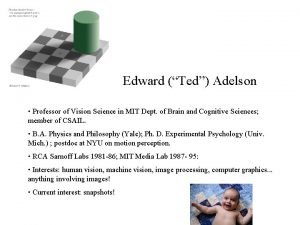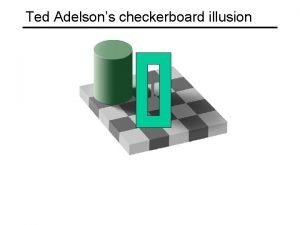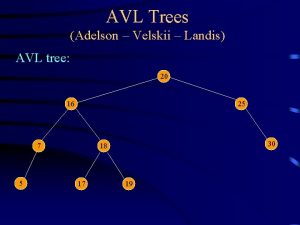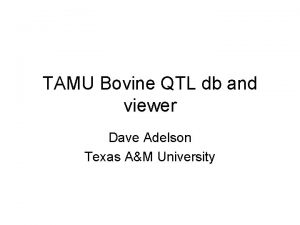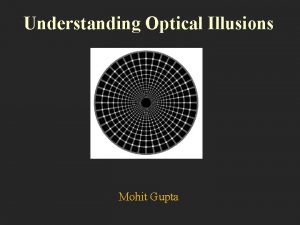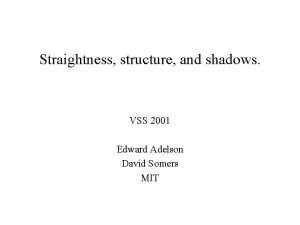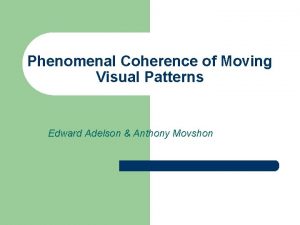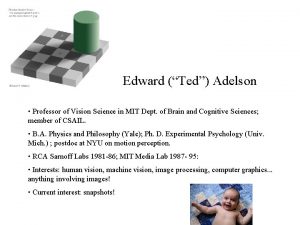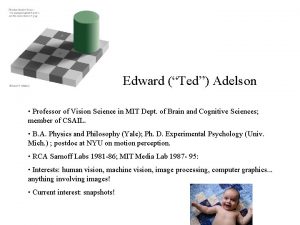Lands Retinex algorithm 9 35 Edward Adelson Lands












- Slides: 12

Land’s Retinex algorithm 9. 35 Edward Adelson

Land’s “Retinex” theory of lightness constancy Edwin Land founded Polaroid. Cameras need correct exposure (both color and Luminance) , i. e. need to “divide out” the effects of illumination. How do humans do it? (Note “Retinex” means “retina plus cortex. ”)

The formal problem Luminance (observed image intensity) = Illumination (incident light) x Reflectance (percent reflected) L(x, y) = I(x, y) x R(x, y) At every pixel you have one number, and you want to estimate two. You can’t unmultiply. It’s impossible (ill-posed). But humans seem to do it. How?

Take advantage of scene statistics. Scene statistics means: some interpretations are more likely than others. For instance, it is common for illumination to vary gradually over space, but for reflectance to vary abruptly (e. g. , to be piecewise constant). Land Mc. Cann used an idealized “toy world” using “Mondrians”. (Image removed due to copyright considerations. )

Using logs, make it additive Start by taking the log on both sides, making it into a simpler additive problem. Thus use log (illumination) instead of illumination, etc. We’ll still call it illumination for simplicity. (Image removed due to copyright considerations. )

Consider it in 1 -D (Image removed due to copyright considerations. ) Image formation is the forward process (Image removed due to copyright considerations. ) Vision is the inverse process.

Land’s proposal: take spatial derivatives and classify them. If they are big (strongly positive or negative), classify as reflectance. (Image removed due to copyright considerations. ) If small, classify as illumination. Integrate big ones to retrieve reflectance. Remainder is illuminance. Note: integration is a form of filling in.

How to implement in neural hardware? One idea: use “edge detectors” in V 1, which take an approximate spatial derivative. Input Response (Image removed due to copyright considerations. )

Craik-O’Brien-Cornsweet effect Indicates the we give strong weight to edges, and not to slow gradients, in computing lightness. (Image removed due to copyright considerations. )

Cornsweet square wave grating The bar centers are the same shades of gray. (Image removed due to copyright considerations. ) The emphasis on edges will make this grating resemble a normal square wave grating.

Levels of analysis (articulated by Marr) • Computational: what is the problem to be solved? • Algorithmic: what approach to solve it? • Implementation: how to actually put it in hardware. Example 1: Calculate x/y (do floating point division). Example 2: Compute pi. Example 3: Do lightness constancy.

Ideas illustrated with Retinex Levels of analysis. Scene statistics to help ill-posed problems. Toy world to help think through a problem. Convergence of ideas from computation, psychophysics, and physiology.
 Ted adelson
Ted adelson Adelsons checkerboard
Adelsons checkerboard Adelson-velsky and landis
Adelson-velsky and landis Dave adelson
Dave adelson Good things come to those who wait
Good things come to those who wait Prof. slim codeforces
Prof. slim codeforces Ao* search algorithm
Ao* search algorithm Chapter 11 section 3 european claim muslim lands
Chapter 11 section 3 european claim muslim lands Louisiana office of state lands
Louisiana office of state lands Sahtu lands
Sahtu lands Lands council spokane
Lands council spokane Flat lands that have only small changes in elevation
Flat lands that have only small changes in elevation Chapter 27 section 3 european claim muslim lands
Chapter 27 section 3 european claim muslim lands
